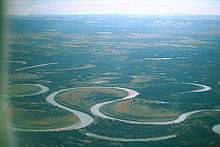Hey, we were taught this in school classes.
It is due to deposition of silt on one side.
Due to this , it goes on bending more and more
An oxbow lake is formed when a river creates a meander due to the
river eroding the banks through hydraulic action and
abrasion/corrosion. After a long period of time this meander becomes
very curved, and eventually the neck of the meander will touch the
opposite side and the river will cut through the neck, cutting off the
meander to form the oxbow lake.
When a river reaches a low-lying plain, often in its final course to the sea or a lake, it meanders widely. In the vicinity of a river bend, deposition occurs on the convex bank (the bank with the smaller radius). In contrast, both lateral erosion and undercutting occur on the cut bank
or concave bank (the bank with the greater radius.) Continuous
deposition on the convex bank and erosion of the concave bank of a
meandering river cause the formation of a very pronounced meander with two concave
banks getting closer. The narrow neck of land between the two
neighbouring concave banks is finally cut through, either by lateral
erosion of the two concave banks or by the strong currents of a flood. When this happens, a new straighter river channel
is created and an abandoned meander loop, called a cut-off, is formed.
When deposition finally seals off the cut-off from the river channel,
an oxbow lake is formed. This process can occur over a time scale from
a few years to several decades and may sometimes become essentially
static.
Gathering of erosion products near the concave bank and transporting them to the convex bank is the work of the secondary flow across the floor of the river in the vicinity of a river bend
It is due to deposition of silt on one side.
Due to this , it goes on bending more and more
An oxbow lake is formed when a river creates a meander due to the
river eroding the banks through hydraulic action and
abrasion/corrosion. After a long period of time this meander becomes
very curved, and eventually the neck of the meander will touch the
opposite side and the river will cut through the neck, cutting off the
meander to form the oxbow lake.
When a river reaches a low-lying plain, often in its final course to the sea or a lake, it meanders widely. In the vicinity of a river bend, deposition occurs on the convex bank (the bank with the smaller radius). In contrast, both lateral erosion and undercutting occur on the cut bank
or concave bank (the bank with the greater radius.) Continuous
deposition on the convex bank and erosion of the concave bank of a
meandering river cause the formation of a very pronounced meander with two concave
banks getting closer. The narrow neck of land between the two
neighbouring concave banks is finally cut through, either by lateral
erosion of the two concave banks or by the strong currents of a flood. When this happens, a new straighter river channel
is created and an abandoned meander loop, called a cut-off, is formed.
When deposition finally seals off the cut-off from the river channel,
an oxbow lake is formed. This process can occur over a time scale from
a few years to several decades and may sometimes become essentially
static.
Gathering of erosion products near the concave bank and transporting them to the convex bank is the work of the secondary flow across the floor of the river in the vicinity of a river bend

